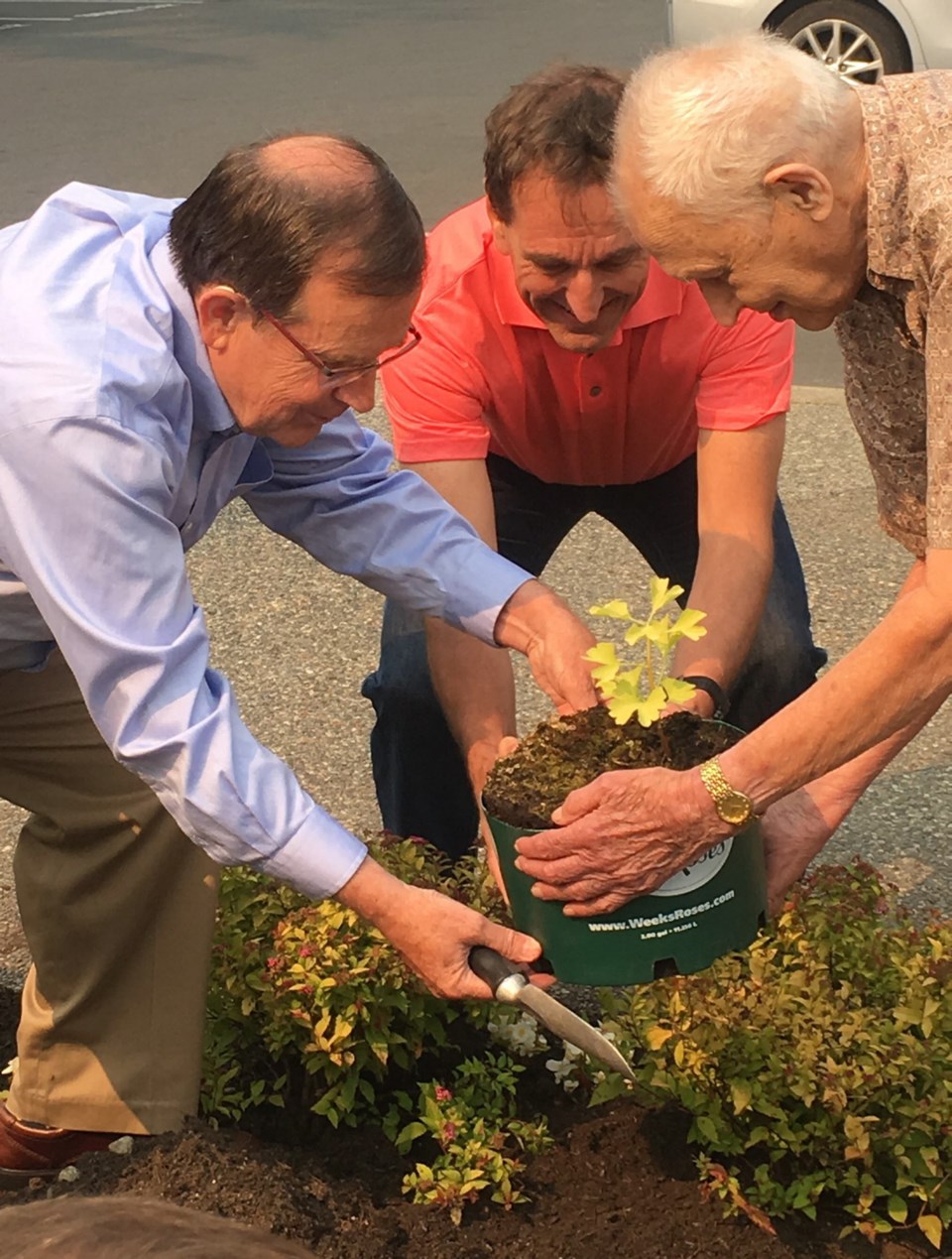 This weekend, Rudi Hoenson planted a seedling in Oak Bay. It came from a tree that, improbably, survived a nuclear blast in Japan — just like Rudi himself.
This weekend, Rudi Hoenson planted a seedling in Oak Bay. It came from a tree that, improbably, survived a nuclear blast in Japan — just like Rudi himself.
You might have heard his story before: Captured as an 18-year-old Dutch soldier in the Second World War, he endured 3 1/2 years of brutality, starvation and forced labour in Nagasaki.
It was there, at 11:02 a.m., Aug. 9, 1945, while clearing the debris from an earlier, conventional air raid — one that had killed the man next to him — that Hoenson glimpsed a parachute falling from a high-up plane, and …
The world erupted. A sudden, blinding, concussive flash, then an instant inferno, the dead and dying rag-dolled among the flaming, flattened buildings. Total horror, as far as the eye could see.
Of the 200 prisoners in the Fukuoka 14 camp when the Nagasaki bomb exploded, Hoenson, 94, is the last survivor.
“I don’t know why I’m still alive,” he says.
Maybe it’s to serve as a real reminder of a threat that is often treated as theoretical.
On Saturday, Hoenson joined Oak Bay Mayor Nils Jensen and Victoria pediatrician Dr. Jonathan Down in planting that seedling beside Athlone Court. It was one of 19 grown by the municipality’s Chris Hyde-Lay from seeds harvested from a ginkgo tree that stood in Hiroshima when that city was bombed three days prior to Nagasaki. Other seeds have been shipped around the world as part of the Mayors For Peace initiative, to which Jensen belongs.
On Wednesday, the anniversary of the Nagasaki bomb, Hoenson will join Down, Lt. Gov. Judith Guichon and others in a memorial event. It’s from 6:30 to 9 p.m. at Esquimalt Gorge Park, at the south end of the Tillicum bridge. Lantern-making, art, music and more.
As demonstrations go, it’s far from the 1980s, when the no-nukes movement was front-page news. A million people marched in Manhattan then, another 600,000 in West Berlin and 300,000 in London. The German-language 99 Luftballons topped English-language music charts. City councils from New York to Nanaimo declared their communities to be nuclear-free zones.
The issue might no longer be as prominent today, but Down, of the Vancouver Island Peace and Disarmament Network, argues it’s no less real.
In January, the Doomsday Clock, the creation of the Bulletin of the Atomic Scientists’ Science and Security Board, which gauges the chances of global catastrophe, clicked up to two and a half minutes to midnight. “That’s the closest it’s been to midnight in many, many, many years,” says Down.
It’s the increasing number of variables that worries the clock-watchers. There are now nine nuclear weapon-owning states, including Kim Jong-un’s North Korea acting like a mouthy bar room drunk getting under Donald Trump’s skin. Victoria is just 100 kilometres from the Kitsap naval base, home to one of the world’s highest concentrations of nuclear weapons.
Again, few people alive today — and almost no one in the English-speaking world — know first hand what nuclear destruction looks like.
Hoenson does. Every time he tells the story — one he kept to himself until just two years ago — more details emerge.
No one escaped unscathed, he says. “Everyone got burned. In my case it was my legs.” It was the exposed skin, he explains: The prisoners wore discarded Japanese uniforms, the pants too short for the tall Dutchmen.
After the blast, those who were still able to walk carried those who weren’t, using ladders and doors as stretchers as they sought safety. As they did, the scope of the destruction grew. The bomb hadn’t exploded over central Nagasaki, where the city’s men went to work each day, but in residential Urakami, where the women, children and elderly were.
Images remain: the delicate kimonos and soft skin of the women bloodied, burned and torn apart by the blast. “That’s where I get nightmares, seeing these women and children.”
With no medical supplies, the prisoners tore up their shirts for bandages. Later, after Hoenson and the other 70 men who could still function were sent to the epicentre to retrieve bodies, he would remove the clothing from the dead for the same purpose. Imagine.
“Every year at this time I get a little … ” Hoenson pauses, “depressed — is that the word? — thinking about what happened.”
Up to 80,000 people died from the Nagasaki blast. Twenty of Hoenson’s fellow prisoners died in the month before he was liberated, and more after that. His two good surviving friends from camp succumbed to leukemia, one seven years after the war, the other in his 60s. “I don’t know how many others died at an early age because of the radiation.”
Yet Hoenson remains.
“What made me healthy was coming to Canada.”
He landed in Canada on Jan. 1, 1952, with $50 in his pocket. Got a job as a geological draftsman on his second day in Calgary. Met the love of his live, Sylvia, six years after that. Worked hard, invested shrewdly, made millions, then gave away millions to causes he believed in. “We had a good life.”
Others weren’t so fortunate.



